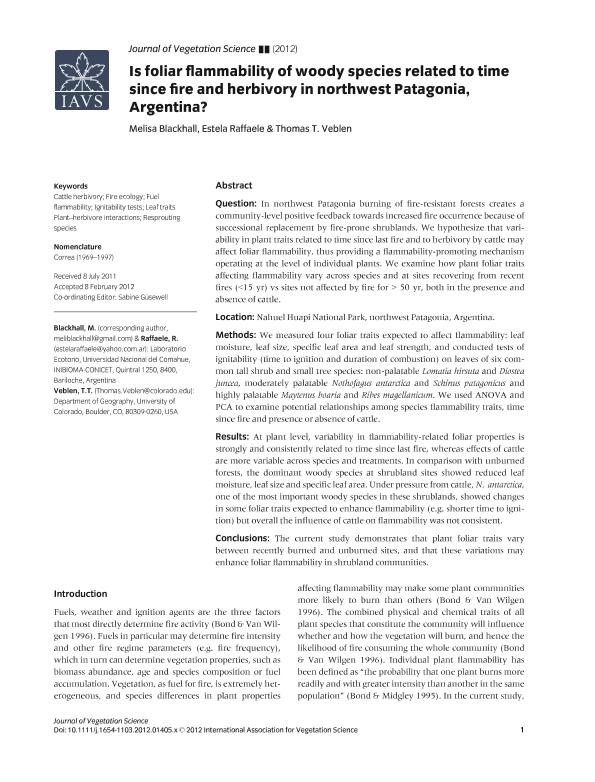Mostrar el registro sencillo del ítem
dc.contributor.author
Blackhall, Melisa

dc.contributor.author
Raffaele, Estela

dc.contributor.author
Veblen, Thomas

dc.date.available
2019-05-03T21:22:01Z
dc.date.issued
2012-10
dc.identifier.citation
Blackhall, Melisa; Raffaele, Estela; Veblen, Thomas; Is foliar flammability of woody species related to time since fire and herbivory in northwest Patagonia, Argentina?; Wiley Blackwell Publishing, Inc; Journal of Vegetation Science; 23; 5; 10-2012; 931-941
dc.identifier.issn
1100-9233
dc.identifier.uri
http://hdl.handle.net/11336/75570
dc.description.abstract
Question: In northwest Patagonia burning of fire-resistant forests creates a community-level positive feedback towards increased fire occurrence because of successional replacement by fire-prone shrublands. We hypothesize that variability in plant traits related to time since last fire and to herbivory by cattle may affect foliar flammability, thus providing a flammability-promoting mechanism operating at the level of individual plants. We examine how plant foliar traits affecting flammability vary across species and at sites recovering from recent fires (<15 yr) vs sites not affected by fire for > 50 yr, both in the presence and absence of cattle. Location: Nahuel Huapi National Park, northwest Patagonia, Argentina. Methods: We measured four foliar traits expected to affect flammability: leaf moisture, leaf size, specific leaf area and leaf strength, and conducted tests of ignitability (time to ignition and duration of combustion) on leaves of six common tall shrub and small tree species: non-palatable Lomatia hirsuta and Diostea juncea, moderately palatable Nothofagus antarctica and Schinus patagonicus and highly palatable Maytenus boaria and Ribes magellanicum. We used ANOVA and PCA to examine potential relationships among species flammability traits, time since fire and presence or absence of cattle. Results: At plant level, variability in flammability-related foliar properties is strongly and consistently related to time since last fire, whereas effects of cattle are more variable across species and treatments. In comparison with unburned forests, the dominant woody species at shrubland sites showed reduced leaf moisture, leaf size and specific leaf area. Under pressure from cattle, N. antarctica, one of the most important woody species in these shrublands, showed changes in some foliar traits expected to enhance flammability (e.g. shorter time to ignition) but overall the influence of cattle on flammability was not consistent. Conclusions: The current study demonstrates that plant foliar traits vary between recently burned and unburned sites, and that these variations may enhance foliar flammability in shrubland communities. We hypothesize that variability in plant traits related to time since last fire and to herbivory by cattle may affect foliar flammability, thus providing a flammability-promoting mechanism operating at the level of individual plants. In northwestern Patagonia, Argentina, plant foliar traits vary between recently burned and unburned sites, and these variations may enhance foliar flammability in shrubland communities.
dc.format
application/pdf
dc.language.iso
eng
dc.publisher
Wiley Blackwell Publishing, Inc

dc.rights
info:eu-repo/semantics/openAccess
dc.rights.uri
https://creativecommons.org/licenses/by-nc-sa/2.5/ar/
dc.subject
Cattle Herbivory
dc.subject
Fire Ecology
dc.subject
Fuel Flammability
dc.subject
Ignitability Tests
dc.subject
Leaf Traits
dc.subject
Plant-Herbivore Interactions
dc.subject
Resprouting Species
dc.subject.classification
Otras Ciencias Biológicas

dc.subject.classification
Ciencias Biológicas

dc.subject.classification
CIENCIAS NATURALES Y EXACTAS

dc.title
Is foliar flammability of woody species related to time since fire and herbivory in northwest Patagonia, Argentina?
dc.type
info:eu-repo/semantics/article
dc.type
info:ar-repo/semantics/artículo
dc.type
info:eu-repo/semantics/publishedVersion
dc.date.updated
2019-04-23T15:10:29Z
dc.journal.volume
23
dc.journal.number
5
dc.journal.pagination
931-941
dc.journal.pais
Reino Unido

dc.journal.ciudad
Londres
dc.description.fil
Fil: Blackhall, Melisa. Consejo Nacional de Investigaciones Científicas y Técnicas. Centro Científico Tecnológico Conicet - Patagonia Norte. Instituto de Investigaciones en Biodiversidad y Medioambiente. Universidad Nacional del Comahue. Centro Regional Universidad Bariloche. Instituto de Investigaciones en Biodiversidad y Medioambiente; Argentina
dc.description.fil
Fil: Raffaele, Estela. Consejo Nacional de Investigaciones Científicas y Técnicas. Centro Científico Tecnológico Conicet - Patagonia Norte. Instituto de Investigaciones en Biodiversidad y Medioambiente. Universidad Nacional del Comahue. Centro Regional Universidad Bariloche. Instituto de Investigaciones en Biodiversidad y Medioambiente; Argentina
dc.description.fil
Fil: Veblen, Thomas. State University of Colorado at Boulder; Estados Unidos
dc.journal.title
Journal of Vegetation Science

dc.relation.alternativeid
info:eu-repo/semantics/altIdentifier/doi/http://dx.doi.org/10.1111/j.1654-1103.2012.01405.x
dc.relation.alternativeid
info:eu-repo/semantics/altIdentifier/url/https://onlinelibrary.wiley.com/doi/abs/10.1111/j.1654-1103.2012.01405.x
Archivos asociados
